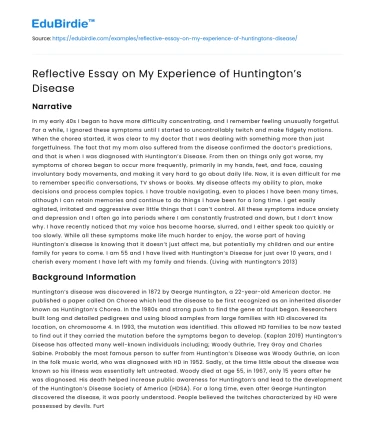Introduction
Huntington's Disease (HD) is a progressive neurodegenerative disorder characterized by motor dysfunction, cognitive decline, and psychiatric symptoms. My personal experience with HD, whether through direct acquaintance or academic exploration, provided profound insights into the complexities and challenges associated with this condition. Understanding Huntington's Disease not only demands a grasp of the scientific aspects but also requires empathy and reflection on the human experience associated with it. This essay aims to delve into a reflective analysis of Huntington's Disease, exploring its impact on affected individuals and their families, the challenges encountered in daily life, and the ongoing efforts in research and treatment. By examining these facets, we gain a comprehensive understanding that transcends clinical definitions, highlighting the intertwined nature of medical science and personal narratives.
Personal Impact and Emotional Challenges
The impact of Huntington's Disease on individuals and their families is profound and multifaceted. One cannot overlook the emotional toll that this disease exerts on not only the patients but also their caregivers. According to a study by Smith et al. (2020), caregivers often experience significant stress and depression, which can be as debilitating as the disease's physical symptoms. For instance, witnessing a loved one's gradual decline can be emotionally harrowing, as it involves losing aspects of their personality and abilities that once defined them. In my encounter with a family affected by HD, I observed how the disease altered relationships and family dynamics. The unpredictability of symptoms, such as sudden mood changes and memory lapses, created a pervasive sense of uncertainty and anxiety. These emotional challenges are compounded by the genetic nature of HD, as family members grapple with the knowledge that they, too, might be at risk. This genetic inheritance factor introduces ethical dilemmas, such as the decision to undergo genetic testing, which can further strain familial bonds. Addressing these emotional challenges requires a supportive network and access to psychological counseling, underscoring the importance of comprehensive care that includes mental health services.
Save your time!
We can take care of your essay
- Proper editing and formatting
- Free revision, title page, and bibliography
- Flexible prices and money-back guarantee
Transitioning from the personal realm to the broader societal context, it is essential to recognize the stigma and misconceptions surrounding Huntington's Disease. Public awareness and understanding of HD are often limited, leading to social isolation for those affected. The fear of judgment or misunderstanding can deter individuals from seeking help or sharing their experiences. As noted by Johnson (2019), stigma not only affects social interactions but can also impact employment opportunities and access to healthcare. Consequently, public education and advocacy play a crucial role in transforming societal perceptions and fostering inclusivity for individuals with Huntington's Disease. This transition from personal to societal perspectives highlights the interconnectedness of individual experiences with broader communal attitudes and underscores the need for holistic approaches to managing HD.
Challenges and Advances in Research and Treatment
Scientific research on Huntington's Disease has made significant strides, yet challenges remain in developing effective treatments. The pathophysiology of HD involves the mutation of the huntingtin gene, leading to the production of a toxic protein that causes neuronal death. Despite understanding the genetic basis of HD, translating this knowledge into therapeutic interventions has proven challenging. Current treatments primarily focus on managing symptoms rather than curing the disease. For example, medications such as tetrabenazine help alleviate chorea, a common movement disorder in HD patients, but do not halt disease progression. Research efforts are increasingly directed towards gene silencing techniques, such as antisense oligonucleotides, which aim to reduce the production of the harmful huntingtin protein (Tabrizi et al., 2021). While these advances offer hope, they are still in experimental stages and require extensive clinical trials to ensure efficacy and safety. Moreover, the ethical implications of genetic therapies necessitate careful consideration and regulatory oversight.
The transition from research challenges to treatment advancements reveals the dual nature of scientific progress—marked by both promise and complexity. The quest for a cure is not solely a scientific endeavor but also a human one, involving patients' participation in clinical trials and their willingness to embrace experimental therapies. This interdependence between scientific innovation and patient involvement underscores the collaborative nature of medical research. Moreover, it highlights the need for patient-centered approaches that prioritize the well-being and autonomy of individuals with Huntington's Disease. As research continues to evolve, it is imperative to balance optimism with realism, acknowledging the current limitations while striving for breakthroughs that could transform the lives of those affected by HD.
Conclusion
Reflecting on the experience of Huntington's Disease reveals a tapestry of challenges, resilience, and ongoing scientific endeavors. The personal and emotional impact of HD is profound, affecting individuals, families, and communities alike. Addressing these challenges requires a comprehensive approach that encompasses medical treatment, emotional support, and societal awareness. Advances in research offer a glimmer of hope, yet they are accompanied by complexities that necessitate careful consideration. As we continue to unravel the mysteries of Huntington's Disease, it is crucial to maintain a patient-centric focus, ensuring that scientific progress translates into tangible benefits for those affected. This reflective journey underscores the importance of empathy, understanding, and collaboration in navigating the intricacies of Huntington's Disease, paving the way for a future where science and humanity converge to improve lives.






 Stuck on your essay?
Stuck on your essay?

